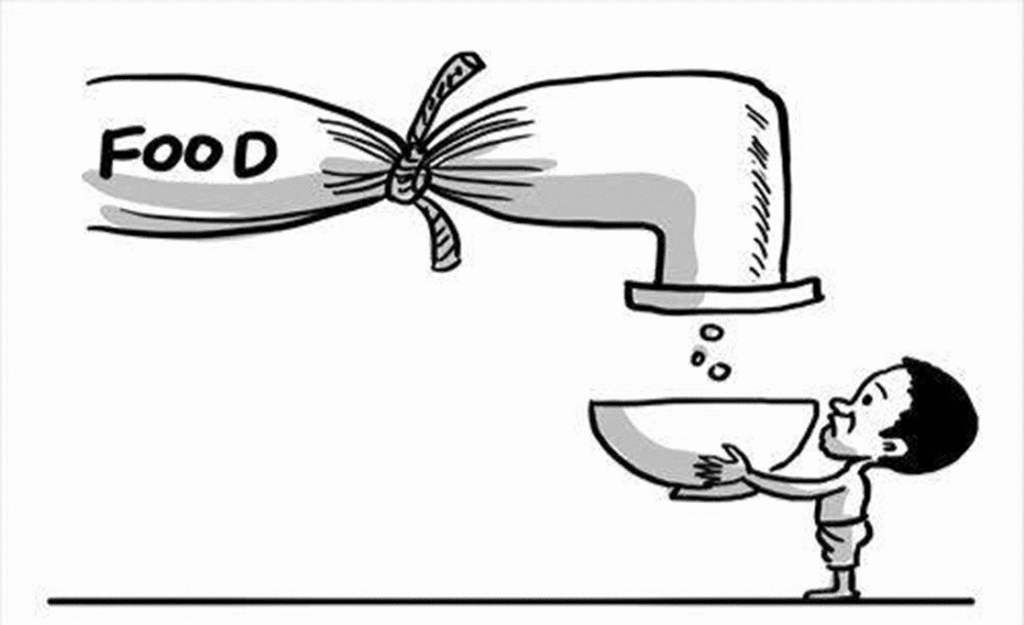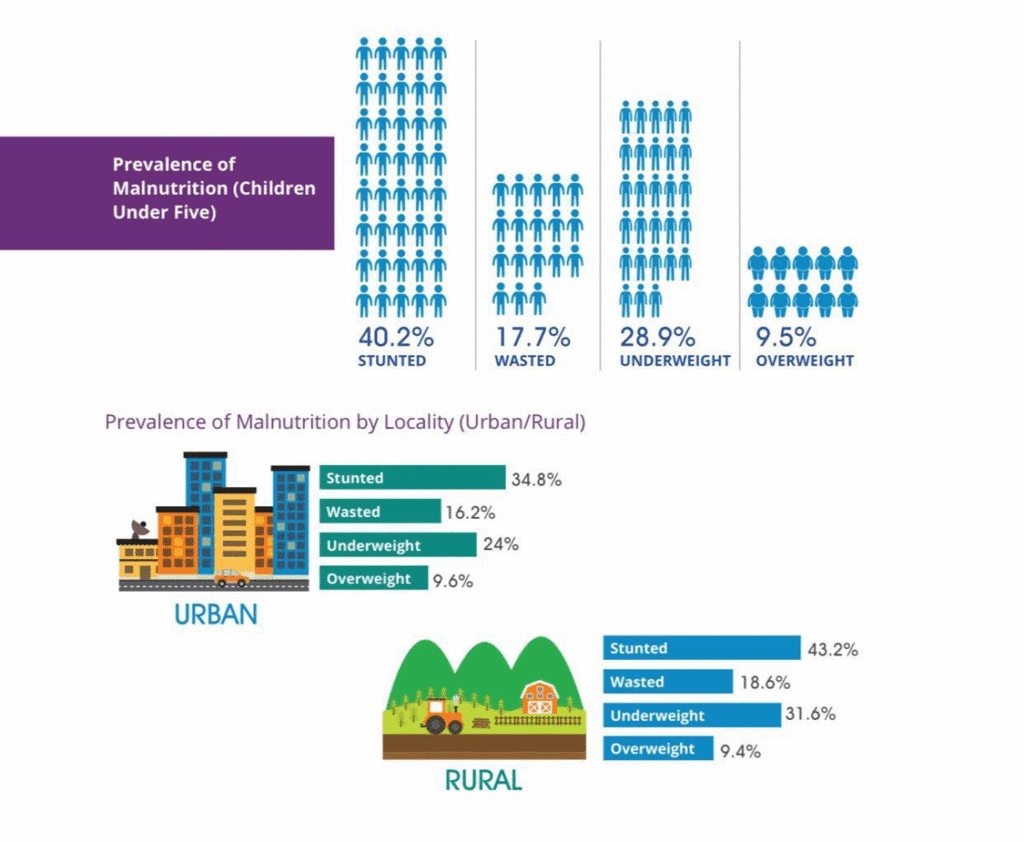Malnutrition, a lack of balance in the nutrients our bodies require, exists in every nation. It involves both under nutrition and over nutrition, with under nutrition compromising the immune system and making people more vulnerable to disease. Although a worldwide problem, Pakistan has a particularly acute situation, requiring immediate action to remedy the causes and save lives. Globally, 148.1 million children under 5 years old were stunted in 2022, and at least 45 million of them had wasting.
Malnutrition issues in Pakistan, the alarming trend is reported where 40.2% of children younger than five years old are afflicted with stunting. This translates into around 12 million children of Pakistan not meeting their full growth potential because of chronic malnutrition. The stunting burden is extremely high, especially in rural regions, where access to proper nutrition, clean water, and sanitation is poor.
IF YOU CAN NOT FEED A HUNDRED PEOPLE, THEN FEED JUST ONE…
MOTHER TERESA

Nutritional Status of Children Under Five Years of Age
- STUNTING
- UNDERWEIGHT
- WASTING
- OVERWEIGHT
Stunting
Stunting refers to impaired growth and development in children due to chronic malnutrition. It is identified when a child’s height-for-age is significantly below the World Health Organization (WHO) growth standards. Stunting typically results from long term insufficient nutrient intake and repeated infections during early childhood. It affects both physical and cognitive development.
Underweight
Underweight indicates that a child’s weight is too low for their age. It may result from either chronic or acute malnutrition. Children who are underweight are more vulnerable to illness, delayed recovery, and developmental delays. It reflects a combination of stunting (chronic) and/or wasting (acute) conditions.
Wasting
Wasting is a condition where a child has a low weight-for-height ratio, indicating acute malnutrition. It often occurs due to a recent and severe lack of food or infection. Wasting is a strong predictor of child mortality, requiring urgent medical and nutritional intervention.
Overweight
Overweight in children occurs when there is excessive body weight relative to height, usually due to an imbalance between calorie intake and expenditure. While often overlooked in malnutrition discussions, childhood overweight is a growing concern globally, including in low-income countries, due to increased consumption of low-nutrient, high-calorie foods.
In Pakistan, four out of ten children under five years of age are stunted while 17.7% suffer from wasting. The double burden of malnutrition is becoming increasingly apparent, with almost one in three children underweight (28.9%) alongside a high prevalence of overweight (9.5%) in the same age group. The prevalence of overweight among children under five has almost doubled over seven years, increasing from 5% in 2011 to 9.5% in 2018.

The pattern of distribution of malnutrition among boys and girls remains the same, with boys being more affected than girls by all forms of malnutrition. Children living in rural areas suffer more from under nutrition (wasting, stunting and wasting) than their peers in urban areas. Overweight affects children equally, irrespective of locality.

Global Malnutrition
Regions
Sub-Saharan Africa
- Stunting affects approximately 33.3% of children under five in Sub-Saharan Africa (UNICEF, 2023).
- This region also records high wasting rates, with over 7% of children acutely malnourished.
South Asia
- South Asia has the highest global burden of stunted children, accounting for over 37% of the world’s total (WHO, 2023).
- In Pakistan alone, 40.2% of children under five are stunted and 17.7% are wasted (National Nutrition Survey, 2018).
Southeast Asia
- The region faces a double burden of malnutrition, with over 25% of children under five stunted and rising overweight rates exceeding 8% in some countries like Indonesia and the Philippines (UNICEF, 2023).
Latin America and the Caribbean
- Undernutrition is declining, but childhood overweight has surged, affecting 9% of children under five (UNICEF-WHO-WB, 2023).
- In Mexico, for example, over 35% of school-aged children are overweight or obese.
Middle East and North Africa (MENA)
- Conflict zones like Yemen report wasting rates over 16%, far above emergency thresholds (WFP, 2023).
- At the same time, overweight in children under five is rising, reaching 10% or more in countries like Egypt and Jordan.
Causes
- Poverty: Restricts access to nutritious food.
- Access: Disproportionate distribution of food resources.
- Sanitation: Poor sanitation causes infections that impair nutrient absorption.
- Conflict: Interferes with food production and supply. 65% of the 343 million acutely hungry people are in fragile or conflict-affected countries.
- Climate Change: Affects agricultural production and availability of food.
Consequences
- Health: Under nutrition is a root cause of approximately 45% of all deaths among children.
- Economic: Affects productivity and economic growth.
- Social: Restricts educational achievement and traps people in poverty cycles.
Malnutrition Issues in Pakistan
Statistics and Regional Disparities
- 40.2% of Pakistani children are stunted, much higher than the regional average.
- Highest stunting prevalence is in Khyber Pakhtunkhwa-Newly Merged Districts (KPK-NMD) at 48.3%.
- Rural stunting prevalence is much higher than in urban areas.
Causes
- Poverty: One of the key causes of food insecurity.
- Food Insecurity: Lack of access to sufficient, safe, and nutritious food.
- Disease: Infections exacerbate malnutrition.
- Health Practices: Poor infant and young child feeding practices. Only 38% of children are exclusively breastfed for the first six months.
- Water: Unsafe water sources contribute to illness.
- Norms: Cultural norms sometimes adversely affect dietary diversity.
Consequences
- Health: Stunting, wasting, and high child mortality.
- Development: Impaired physical and cognitive development.
- Economic: Lower workforce productivity.
- Social: Restricts opportunities and perpetuates inequality.
Addressing Malnutrition

Global Efforts to Reduce Malnutrition
UNICEF and WHO Programs
Global organizations like UNICEF, WHO, and WFP lead initiatives targeting child malnutrition through nutrition-specific and nutrition sensitive interventions. Programs such as Scaling Up Nutrition (SUN) and Global Nutrition Report track progress and support governments in reducing stunting and wasting.
Sustainable Development Goal 2 (Zero Hunger)
The United Nations’ SDG 2 aims to end hunger and all forms of malnutrition by 2030. It promotes food security, improved agricultural productivity, and universal access to safe and nutritious food.
Micronutrient Supplementation
Global health bodies support Vitamin A, iron, and folic acid supplementation, especially for pregnant women and children under five, to combat hidden hunger.
Local Efforts in Pakistan
National Nutrition Survey
Pakistan regularly conducts the National Nutrition Survey to assess malnutrition prevalence and guide policy. The latest (2018) data informs government and donor led programs.
Ehsaas Nashonuma Program
This government initiative provides monthly food and cash support to pregnant women and children under two in food-insecure districts, aiming to reduce stunting.
Fortification Programs
The government, with support from GAIN and other international partners, has introduced wheat flour and edible oil fortification to address micronutrient deficiencies.
Key Challenges or Limitations
Poverty and Food Insecurity
High poverty levels in Pakistan and parts of the global south limit access to diverse, nutritious food, especially in rural and conflict-affected areas.
Poor Health Infrastructure
Inadequate health services and lack of trained staff hinder early detection and treatment of malnutrition, particularly in remote regions.
Cultural Practices and Lack of Awareness
In both global and Pakistani contexts, traditional beliefs, low female education, and poor breastfeeding practices contribute to malnutrition.
Climate Change and Conflict
Global and local food systems are increasingly affected by climate events and political instability, disrupting food production and access.
Strategies to Overcome Malnutrition
Global Strategies
1. Waste to Protein Systems for Sustainable Nutrition
Innovative waste to protein technologies convert agricultural and food industry waste into edible protein sources. These systems utilize chemical, physical, and biological treatments to transform waste streams into food-grade proteins, offering a sustainable approach to address global protein deficiencies.
2. Explainable AI for Early Malnutrition Detection
The integration of Explainable Artificial Intelligence (XAI) with mobile health (mHealth) platforms enables early and accurate detection of malnutrition risks. By analyzing clinical and health data, XAI models can identify at-risk individuals, facilitating timely interventions and personalized nutrition plans.
3. Corporate Partnerships Enhancing Food Security
Collaborations between corporations and food banks have proven effective in addressing food insecurity. For instance, Nestlé’s partnerships have led to significant contributions, including the donation of over 140 million food servings globally in 2023, and the development of nutrition education programs to improve dietary habits.
Innovative Approaches in Pakistan
1. Farmer Field Schools Promoting Climate Resilient Agriculture
In Sindh province, Farmer Field Schools educate local farmers on sustainable practices such as vertical gardening and the cultivation of climate resilient crops. These initiatives have improved food diversity and nutrition among communities facing high soil salinity and water scarcity.
2. Land Information and Management System (LIMS)
Pakistan’s LIMS utilizes geospatial technologies to provide farmers with real-time data on soil conditions, weather patterns, and crop monitoring. This system enhances agricultural productivity and supports food security by optimizing land use and farming practices.
3. Integration of Nutrition Services into Primary Healthcare
Efforts are underway to incorporate essential nutrition interventions into Pakistan’s primary healthcare system. This includes training community health workers, producing local therapeutic foods, and integrating nutrition indicators into health information systems to improve service delivery and monitoring.
Conclusion & Call to Action
The harsh realities presented emphasize the necessity to address malnutrition as a life-or- death crisis requiring immediate and holistic attention. To effectively respond to this worldwide problem, it is necessary for people and communities to aggressively support agencies on the front line, tirelessly fighting hunger and its horrific outcome. In addition, an important step is to advocate for strong policies that address the underlying causes of malnutrition, such as widespread poverty and general food insecurity.
Providing universal access to clean water and better sanitation is also essential in making healthier environments and preventing illness that worsens nutritional deficiencies. Although the situation is dire, a brighter future is still within sight. Together with cooperation, we can dream of a world where there are no children that are not given the chance to flourish, unburdened by the debilitating impact of malnutrition.
BY WORKING TOGETHER , WE CAN CREATE A FUTURE WHERE ALL CHILDREN HAVE THE OPPORTUNITY TO THRIVE …………..

 Medically reviewed by
Medically reviewed by